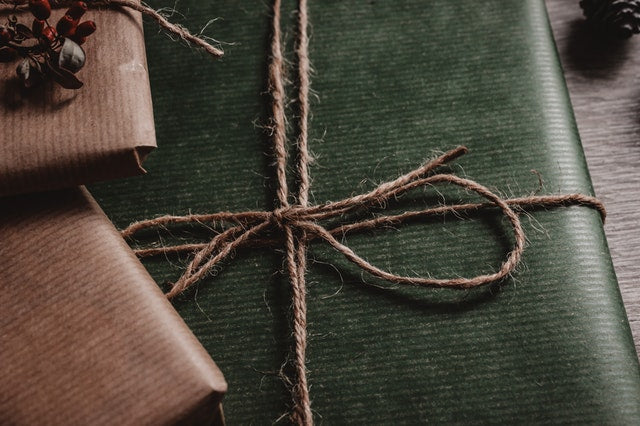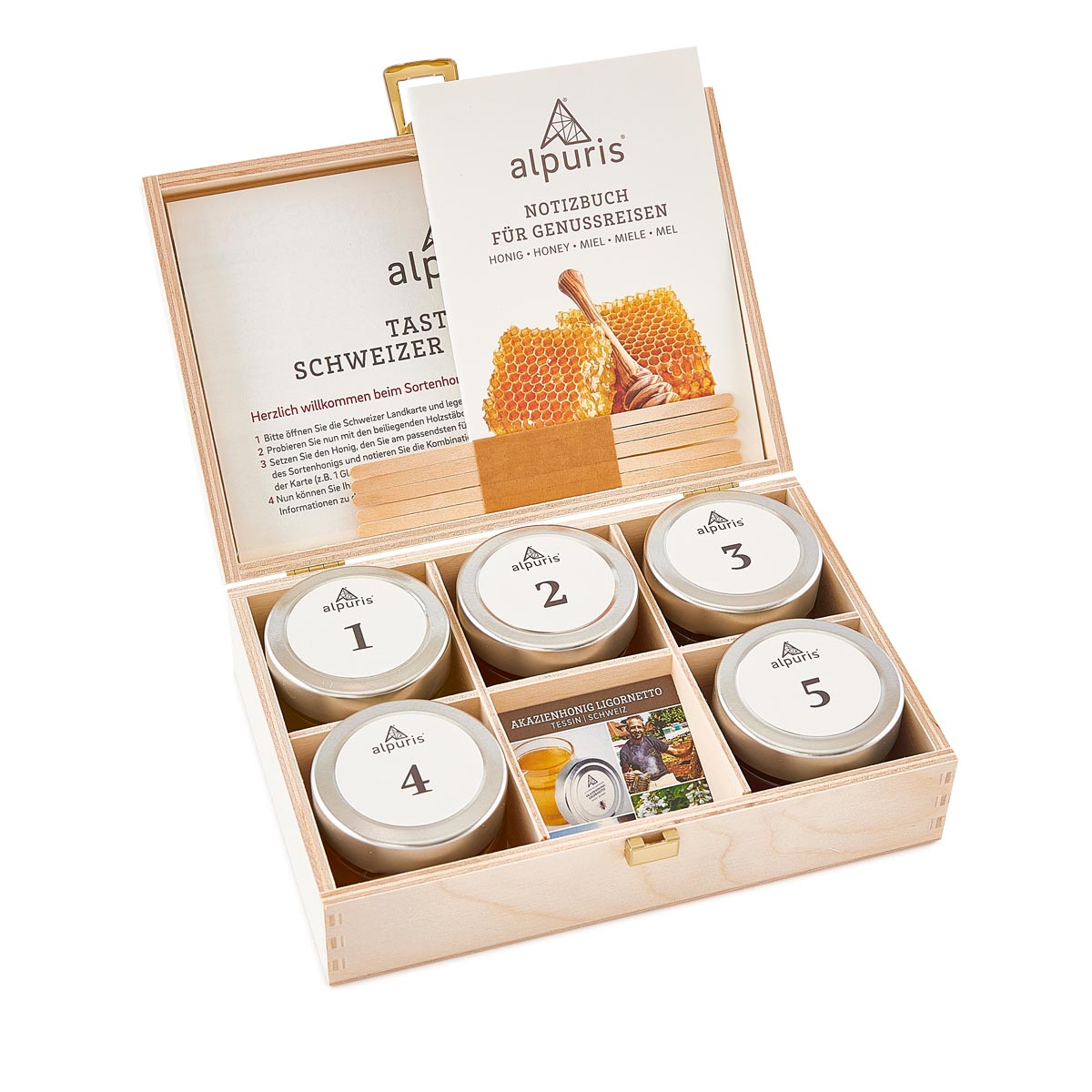
Beekeeping lexicon: The most important terms for beekeeping explained from A - Z
Interesting facts about bees and beekeeping briefly explained:
Apis mellifera is the scientific name of the honey bee. This species, in turn, splits into several races:
- Apis mellifera mellifera (= dark or black bee, the original native bee breed of Switzerland)
- Apis mellifera carnica
- Apis mellifera caucasica
- Apis mellifera ligustica
Worker. There are three types of bees in a colony: queen, drone, and worker. In terms of numbers, female workers far outnumber them. They take care of the brood, clean the hive and gather the food.
Prey. This is what the artificial dwelling for bees is called. A distinction is made according to material (wood, plastic, clay, straw, ...) or according to construction: magazine, trough, log hive, ...). Nowadays, the magazine hive is mainly used, which is composed of several "building blocks" and can be used in a wide variety of ways.
Bee bread. The pollen stored and preserved/fermented in the honeycomb.
Bee venom (medical: apitoxin) is a mixture of different secretions that signals other bees when one of their colony has been attacked and they should prepare to defend themselves.
Beeswax is the building material for the honeycomb. The workers produce the wax themselves in the wax glands. Not only is it made into candles, it is also used in the cosmetics and food industries.
Flowering consistency. A bee visits only one type of flower during a foraging flight. Only in this way is the probability of fertilization of the flowers subsequently visited sufficiently high.
Brood. All of the offspring of the bees, i.e. the eggs (pens), the larvae and the pupae. The queen lays a single egg in each honeycomb cell. The developing larvae are fed by nurse bees in the cell and molt there several times. The metamorphosis in the pupal stage also takes place in the (then capped) cell. The insect only slips out of the cell when the bee is complete.
Brood chamber. This is the bottom frame of the beehive. Above it are the honey chambers.
Drone. Denotes the male bee. It develops from an unfertilized egg and has no sting. In the period from May to July there are several hundred drones in a bee colony. Her only job is to mate with a young queen on her nuptial flight. However, the drone pays for this with its life.
Foulbrood. A bee disease caused by bacteria. A distinction is made between the (often benign) European foulbrood and the (malicious) American foulbrood.
Flavonoids. A group of substances that became known as plant pigments. Many have a medicinal effect: vasoconstrictive, anti-inflammatory, antiviral or antispasmodic. Others are valuable antioxidants. Flavonoids are partly responsible for the color of honey.
Flight circle. Area around the bee location where the bees fly. Its maximum radius is usually up to 3.5 km, but can extend (in extreme cases, especially in arid areas) up to 9 km.
Royal jelly. This is a feed juice that the nurse bees prepare from the secretions of their salivary glands and mandible glands and feed it to all bee larvae for 3 or 4 days. While the composition then changes in the worker and drone brood, the larvae of the later queens receive only royal jelly throughout their rearing.
Hydroxymethylfurfural, HMF for short , is a breakdown product of the sugar that can form in honey. It occurs more often when honey has been stored too warm or has been heated too much. A low HMF value is therefore a quality criterion for honey, while high HMF levels indicate storage and heat damage.
nuptial flight. One-time mating flight of the queen, during which she is mated by up to 12 drones during flight. While the males die in the act, the queen collects the sperm store in a specially designed bladder. He serves her for the rest of her life to fertilize the eggs she lays.
Honey. A food that honey bees make from the nectar of flowers or the secretions of plant lice (honeydew). Bees store honey in honeycombs in the hive to provide food for the winter.
honey room. These are the upper frames of the hive.
honeydew. Secretion from certain plant-sucking insects (e.g. aphids, bark or scale insects), which mainly consists of sugar. It occurs when these insects tap into and absorb the sap of the trees. Bees collect this honeydew and carry it in. This produces forest honey (honeydew honey).
inhibins. General term for active ingredients that inhibit the growth of germs. They can belong to very different groups of chemical substances. How the substances work is mostly still unknown. The flavonoids (plant pigments) contained in honey are also counted among the inhibins.
putty resin. Another word for propolis.
Queen. She is the only sexually mature female in the bee colony. Only she was mated by several drones and consequently only she lays fertilized eggs in the hive.
Magazine (loot). A modern magazine hive consists of an open grid floor, several frames for brood and honey chambers and a lid. It is put together as required, is processed from above and can be set up freely.
melecitosis. A triple sugar consisting of 2 molecules of glucose linked by a molecule of fructose. Melezitose occurs frequently in honeydew and crystallizes extremely quickly, so that honeys with a high proportion of melezitose can sometimes no longer be extracted. A small amount of melezitose gives a forest honey a very typical, full flavor.
center wall. Beeswax sheet with an embossed cell pattern. The bees lengthen this predetermined pattern so that a complete honeycomb is finally formed.
natural comb construction. Here the bees build honeycomb without a cell pattern being specified. The bees put it on wherever there is space and nothing is given to them, e.g. in the construction frame, in empty frames or natural cavities.
Nectar. A sugary, plant-based glandular sap that some flowers produce to attract bees. Depending on the plant species, the weather and the time of day, the amount of nectar released varies. The bees produce honey from the nectar.
pollen. It is also commonly called "pollen". Pollen is the male germ cells of plants. The bees use it as protein food for their brood. Pollen usually has a spherical shape, but each plant species has a characteristic surface structure. Analysis of this structure in the laboratory allows assignment to the plant family.
propolis. Tree resin that the bees collect to seal their hive. That is why it is also called putty resin. It has a bactericidal and fungicidal effect.
round dance. A returning bee tells the other flying bees that it has found a food source in the immediate vicinity (less than 100 m). There is no indication of the direction.
waggle dance. A returning bee tells the other flying bees that it has found a food source at a greater distance (more than 100 m). Information on distance and direction is given.
swarm. Natural need of a bee colony to reproduce by division. Takes place mainly in May and June and depends on the strength of the colony, but also on the weather and the range of traditional costumes. If, for example, the queen no longer has enough space to lay eggs due to the large amount of honey brought in, then the swarm mood increases.
Swiss box. Describes the traditional way of beekeeping in Switzerland, in which each bee colony is kept in its own box and all boxes are kept together in a fixed place, the bee house. In Swiss bees, the bees are cared for from inside the apiary, from behind, and not from above, as is the case with magazines.
smoker. A device for producing smoke using a bellows. This gives the bees the illusion of a forest fire. These react instinctively and fill their honey stomachs as they prepare to leave their dwelling. The beekeeper uses this “occupation” to be able to work in the hive for a while without being disturbed by the bees.
summer bees. This refers to workers who are born between March and August. Their average lifespan is extremely short compared to winter bees. It's four to five weeks.
Pen. A pen is the egg deposited in a cell by the queen. The laying of eggs is therefore referred to as "pinning".
hive bees. Collective term for all bees that have not yet/hardly left the hive or are not yet flying bees. After hatching, the hive bees carry out a wide variety of activities in the hive, eg cleaning, caring for the brood, building honeycombs, maintaining supplies, guarding the flight hole, etc. The activities they carry out depend on their age. The bees build more combs between the ages of 12 and 18 days, since their wax glands are best developed at this age. They only become flying bees when they are around 20 days old.
costume. Describes the (sum of) plants that currently provide pollen, nectar or honeydew as a nutritional basis for bees. A good costume is the basis for good honey. According to the seasons, the beekeeper differentiates between early forage, summer forage and late forage. Mass breeding occurs when there are extremely large amounts of pollen and nectar, for example when rape is in bloom.
Varroa mite. The varroa destructor was introduced from Asia and first appeared here in the early 1970s. This is one
Parasite that affects both bees and their brood, but only multiplies in the brood. The mite feeds on the hemolymph of the bees. It has become a serious threat to our bee colonies.
Honeycomb. A bee nest consists of several honeycombs. The bees build the honeycomb from the beeswax they produce. The honeycomb consists of a large number of regularly arranged, hexagonal cells. The cells are used for brood care and storage. Combs that are used exclusively for storage are called honeycombs. These are taken from the colony for the honey harvest and then centrifuged.
forest costume. At certain times of the summer, the forest can “honey”, ie insects sucking plants excrete a liquid rich in sugar (“honeydew”). The bees collect these and carry them into their hive, from which honey is then produced. That is why this honey is also called forest honey. It contains less glucose than blossom honey and therefore stays liquid longer.
Hike. Moving the bee colonies to a different location to use different honeycombs to obtain different (variety) honeys. Beekeepers like to hike in dandelion, rapeseed, linden or forest costumes.
queen. designation for the queen.
winter bees. This refers to workers who hatch in late summer and fall. Their lifespan is extremely long compared to summer bees and is several months.
winter grape. Depending on the outside temperature, the bees contract into a spherical bee cluster in order to keep the temperature inside at values between 20 and 35° C through constant movements of the flight muscles. In healthy colonies, the temperature inside the grape never drops below 15°C.
economic people. A colony of bees that is at least one year old. It has overwintered successfully and is so vigorous in development that it can bring in sufficient forage to build up reserves of honey. It can also be referred to as "old people".
Frame. The parts of a magazine hive in which the combs hang. Depending on the season and/or mode of operation, a hive consists of at least one, up to four or even five boxes.




